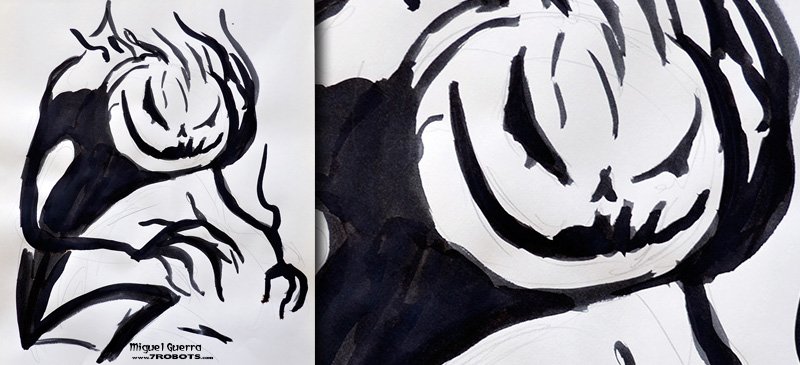
Horror Ink Sketches
As part of our Halloween countdown, we’re posting one new ink sketch every day until the 31st. But Miguel was caught in a creative frenzy for a few days and created a ton more! So, we’ll continue to post all 25 of his horror sketches!
★To see all of the Horror Ink Sketches, click here.
The Legend of Sleepy Hollow by Washington Irving
“The Legend of Sleepy Hollow, short story by Washington Irving, first published in The Sketch Book in 1819–20. The protagonist of the story, Ichabod Crane, is a Yankee schoolteacher who lives in Sleepy Hollow, a Dutch enclave on the Hudson River. A suggestible man, Crane believes the ghost stories and tales of witchcraft he has heard and read. He is particularly impressed by the tale of a spectral headless horseman said to haunt the area. Crane is also mercenary; he courts Katrina Van Tassel mostly because she is the daughter of a rich farmer and is expected to receive a large inheritance. Abraham Van Brunt (also called Brom Bones) is Crane’s jealous rival, a local favourite and a rash horseman who often plays tricks on the schoolmaster. Late one night as Ichabod Crane rides home from a party at Katrina’s home, he is suddenly frightened by a ghostlike headless horseman. The ghost pursues him and hurls at him a round object that he takes to be a head but is later revealed to have been a pumpkin. The schoolmaster is never seen in Sleepy Hollow again.” [click here to read more]
Headless Horsemen
“Headless horsemen were staples of Northern European storytelling, featuring in German, Irish (e.g. Dullahan), Scandinavian (e.g. the Wild Hunt) and English legends and were included in Robert Burns’s “Tam o’ Shanter” (1790), and Burger’s Der wilde Jager, translated as The Wild Huntsman (1796). Usually viewed as omens of ill-fortune for those who chose to disregard their apparitions, these specters found their victims in proud, scheming persons and characters with hubris and arrogance. The chief part of the stories, however, turned upon the favorite specter of Sleepy Hollow, the Headless Horseman, who had been heard several times of late, patrolling the country; and, it was said, tethered his horse nightly among the graves in the churchyard.” [click here to read more]
